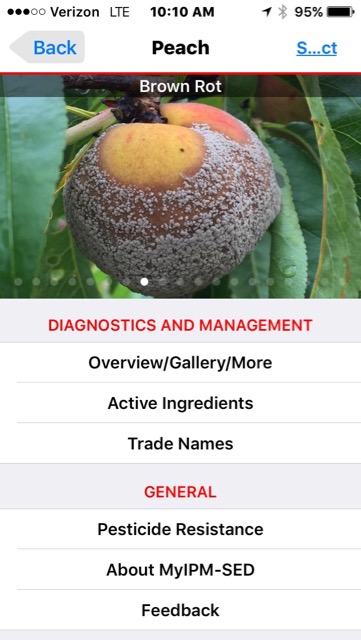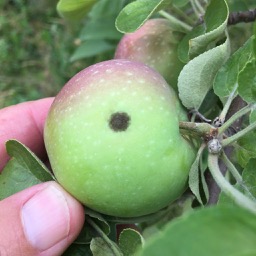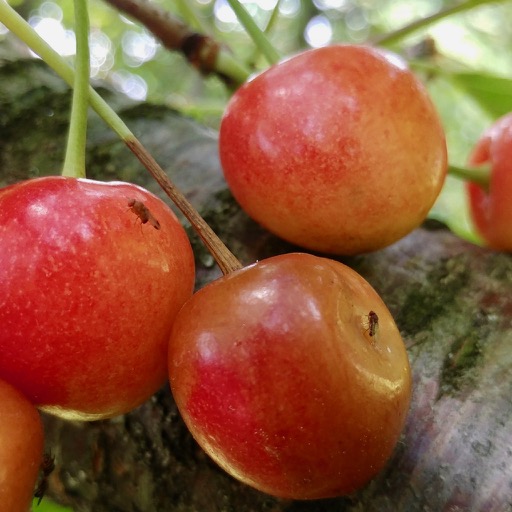

Jon Clements, Author (unless otherwise noted) and Editor
Note: current (July 10) DD Base 43 BE accumualtion, Belchertown, MA = 1889
| Coming events | Degree days (Base 43 BE) |
| Apple maggot 1st catch | 1225-1661 |
| Apple maggot 1st oviposition punctures | 1605-2157 |
| Codling moth 2nd flight starts | 1775-2234 |
| Dogwood borer flight peak | 1434-1864 |
| Lesser appleworm 2nd flight starts | 1429-2108 |
| Obliquebanded leafroller 1st flight subsides | 1622-2041 |
| Oriental fruit moth 2nd flight peak | 1448-1954 |
| Redbanded leafroller 2nd flight peak | 1535-1984 |
| San Jose scale 2nd flight starts | 1629-1979 |
| Spotted tentiform leafminer 2nd generation tissue feeders | 1378-2035 |
*Adapted from Scaffolds Fruit Journal
Key insect life cycle and management dates and preliminary McIntosh harvest date forecasts
Note: for 2017, we have four Massachusetts orchard locations subscribed to AR: Amherst, Belchertown, Deerfield, and Easthampton. The website for looking at AgRadar for these locations is: http://extension.umaine.edu/ipm/ag-radar-apple-sites/. What follows is the AgRadar summary for the Belchertown location.
Apple Maggot Fly AMF -- Rough guess of date first apple maggot flies are caught on traps is: Thursday, June 29. Rough guess of peak AM trap captures is: August 2, Wednesday.
Dogwood borer DB -- First egg hatch roughly: June 22. Peak hatch roughly: July 26.
Codling moth CM -- 2nd generation 7% CM egg hatch: July 27, Thursday, = target date for first spray where multiple sprays needed to control 2nd generation CM. 2nd generation 30% CM egg hatch: August 6, Sunday, = target date where one spray needed to control 2nd generation CM.
Lesser Appleworm LAW -- 2nd LAW flight begins around: July 9, Sunday.
Oriental Fruit Moth OFM -- 2nd generation - first treatment date, if needed: July 3, Monday. 2nd generation - second treatment date, if needed: July 14, Friday.
Redbanded Leafroller RBLR -- 2nd RBLR flight begins around June 26, Monday. Peak catch and approximate start of egg hatch: July 9.
Spotted Tentiform Leafminer STLM -- 2nd STLM flight begins around: June 14, Wednesday. Rough guess of when 2nd generation sap-feeding mines begin showing: July 2, Sunday. Optimum first sample date for 2nd generation STLM sapfeeding mines is July 9, Sunday. Second optimized sample date for 2nd generation STLM sapfeeding mines, if needed: July 15, Saturday. Third optimized sample date for 2nd generation STLM sapfeeding mines, if needed: July 26, Wednesday.
Preliminary McIntosh harvest date forecast -- Date to apply ReTain to delay first harvest for apples which without treatment would be ready for storage harvest on September 2 is from Saturday August 5 to August 12. Date to apply ReTain to delay maturity for 2nd, 3rd or 4th pick of those apples, without delaying start of harvest maturity, is from Saturday, August 19 to August 26. Begin measuring actual McIntosh starch-iodine index no later than Saturday, August 26. The Michigan formula estimates that non-spur McIntosh will reach starch index 4.0 and start the optimum harvest window for long term storage on Saturday, September 2. Using the Hudson Valley NY formula, McIntosh maturity is forecast to reach starch index 6.0 in Belchertown MA on Saturday, September 23.
Jon Clements
I am way behind this week on account of a visit from a colleague from California on Monday, the MFGA summer meeting yesterday, and orchard scouting visits today. (Tomorrow I visit a newly planted apple orchard that has seen significant tree mortality.) Thus, HF will be much ABBREVIATED this week. In fact, here I am only going to excerpt from my scouting notes for today's orchard visits, including links to further important information for this time of year. Thanks for your patience. JC
Discussion about using MyIPM-SED app for rotating peach fungicides for brown rot; see: http://www.clemson.edu/extension/peach/commercial/diseases/myipmsmartphoneappseries.html

Need to have a nutrient management plan in hand, can be found here: http://fruit.umext.umass.edu/tfruit/nutrient/
Take leaf analysis samples 3rd or 4th week in July and submit to UMass lab: http://ag.umass.edu/services/soil-plant-nutrient-testing-laboratory/lab-services
Scab-resistant block, some issues with fruit deformity/russetting of Pristine? also Pristine is very biennial; otherwise apples looked clean compared to last year (no PC, no EAS); one Apple Maggot Fly caught on red trap, below threshold, but keep monitoring; see: http://blogs.cornell.edu/jentsch/2017/07/12/when-it-rains-apple-maggot-emergence-july-12th-2017/
Still active scab observed on foliage and fruit of larger McIntosh trees (you are not alone); secondary scab should be slowing down, but keep it under consideration, and more fungicide applications with Captan may be warranted, as for summer diseases too

No new Codling Moth in pheromone trap, should be between generations, watch for second generation flight
ObliqueBanded Leaf Roller still being caught, no sign of larvae in foliage though, adult moths probably coming in from abandoned orchard, and insecticide sprays (Assail) taking care of in orchard; flight should be declining
Spotted Tentiform Leaf Miner, lots of little moths, but unclear as to species composition (STLM, apple leafminer, apple blotch leafminer?), no leaf mines observed, again likely coming from abandoned orchard, assume current insecticides schedule is taking care of; continue to scout for presence of leaf mines
Peach Tree Borers, no new moths caught
Second Apple Maggot Fly trap checked, negative for flies, no flies or injury observed (yet) in Delicious tree that had a lot of AMF injury last year
Lots of mites and bronzing across the board, mostly European Red Mited, but including some Two Spotted Spider Mite (ugh) in dwarf Honeycrisp; recent Portal application seems to have slowed them down significantly, keep monitoring for presence of motile mites
Observed sunburned Honeycrisp where hand-thinned fruit removed (don't hand-thin during hot, sunny weather?)

Spotted Wing Drosophila trap missing (bear?); assume you have SWD in berries, and maybe peaches, need to control with insecticides; see: http://ag.umass.edu/fruit/news/2017-swd-insecticide-recommendations-for-small-fruit-stone-fruit; don't let peach fruit get over-ripe on trees
Birds eating cherries, next year try Avian Control spray: http://aviancontrolinc.com/products/avian-control/
Few Japanese Beetles noted in peaches, keep an eye on, can get out of hand rapidly and consume foliage and ripe fruit, Assail applications would continue to keep at bay
For summer disease fruit rot management in apple: https://blogs.cornell.edu/plantpathhvl/files/2017/07/17-07-New-bitter-rot-control-strategies-sjjc9c.pdf
Sweet cherry orchard infested with Spotted Wing Drosophila; see: http://msue.anr.msu.edu/news/managing_spotted_wing_drosophila_in_cherries_at_harvest_time; problem exacerbated by large trees, highly shaded canopy, and wet weather; prune ASAP and plant new cherry orchard; assume you will have SWD problems in berries and maybe peaches, don't let peaches get over-ripe on trees!

Pear Psylla? sprayed Portal, nothing of note found, however, seems to be some honeydew on water sprouts? (damn pear psylla!) no action required now, scout for presence of nymphs or adults weekly to determine need for re-treatment
Peach orchard needs nitrogen, it's a little late, but go-ahead and apply modest rate to ground ASAP, don't wait long to do it! (don't wait period!); take a leaf analysis to confirm deficiency (http://ag.umass.edu/services/soil-plant-nutrient-testing-laboratory/lab-services); continue hand-thinning, but need to pick up the pace using whiffle ball bats or similar!
tart cherries have SWD infestation too, spray with insecticide on regular basis (Imidan can be used on tart cherries, but watch PHI), see: http://ag.umass.edu/fruit/news/2017-swd-insecticide-recommendations-for-small-fruit-stone-fruit; assume you have SWD problems in all berries too!!!
No Insects/Liz's corner report (I'll call her out on it, she is on vacation!!!)
No particular Diseases report. It's wet. Keep spraying fungicides for secondary scab (until you know it's burned out, should become less of an issue as the summer progresses) and summer diseases/fruit rots. See David Rosenberger article https://blogs.cornell.edu/plantpathhvl/files/2017/07/17-07-New-bitter-rot-control-strategies-sjjc9c.pdf) and consult NEWA for need to spray...
Jon Clements
Calcium sprays should be ongoing (http://ag.umass.edu/fruit/fact-sheets/foliar-calcium-sprays-for-apples).
Could almost begin collecting foliar nutrient analysis samples any time now and submitting to UMass Soil and Plant Nutrient Testing Laboratory (http://ag.umass.edu/services/soil-plant-nutrient-testing-laboratory/lab-services) Collect and submit by first week in August.
No Guest article this week. See links above to blog posts from Peter Jentsch (apple maggot fly) and David Rosenberger (summer fruit rots).
Follow me (jmcextman) on FB: https://www.facebook.com/jmcextman

New England Tree Fruit Management Guide
UMass Fruit Advisor: http://umassfruit.com
Scaffolds Fruit Journal: http://www.nysaes.cornell.edu/ent/scafolds/
Network for Environment and Weather Applications (NEWA): http://newa.cornell.edu
Follow me on Twitter (http://twitter.com/jmcextman) and Facebook (http://www.facebook.com/jmcextman)
The next Healthy Fruit will be published on Tuesday, July 25 or thereabouts, 2017. As always feel free to get in touch with any member of the UMass Fruit Team (http://extension.umass.edu/fruitadvisor/team-members) if you have questions or comments.